I’m not sure if it’s the New Yorker in me or perhaps my parent’s constant reminders that I could do anything I put my mind to, but somehow I find I sign up for things that I’m ill prepared for. Call it gumption, or more fittingly, stupidity. It’s at these times that I wonder why I think it’s fun to put myself through what has lovingly been coined “Type B Fun.” The sort of activity that only feels enjoyable in hindsight. In the moment, you hate every second and reassure yourself that you’ll never do it again. But already I feel the rose colored glasses slipping onto my face and tinting this experience for the better. So, before my notes feel distant and my mind plays tricks on me, I’ll share with you my personal experience of the Mera Peak Trek.
Day 1 – Lukla to Paiya
This is hell. My guide skips up the mountain ahead of me and throws up his hands with frustration when he looks back and realizes that yes, I’ve stopped again. I can see the look in his eyes. I’m a dud. I’ll never make it.
“Tomorrow we go straight to Panggom. Other way is little hard for you I think.”
It’s only day one and he’s already cutting days out of the schedule. Clearly I’ve made a wonderful impression. My entire body aches like I’ve been bruised all over. After spending three days stranded at the airport with no flights to Lukla, I feel like my leg muscles are about to atrophy. I barely drank any water because I was sure my flight would be called any second over the course of 72 hours, and I didn’t want to have to pee on the teeny tiny 12 seater plane where a small bump in turbulence feels like a “Maiday we’re going down!” moment.
So here I am, dehydrated and feeling like hell, barely able to eat my lunch which is loaded with so much chili that its left a rash on my upper lip. On top of all of that, my stomach feels tense, and I think I might vomit. We’ve walked up approximately 700m of uneven stone steps. That’s 2,296 feet. The Empire State Building only has 1,576 steps, which means that in order to prepare for this trek back home, I would have to climb the Empire State Building one and a half times (at least) just to train for the uphill portion of this little expedition. Why did I pay money to do this?
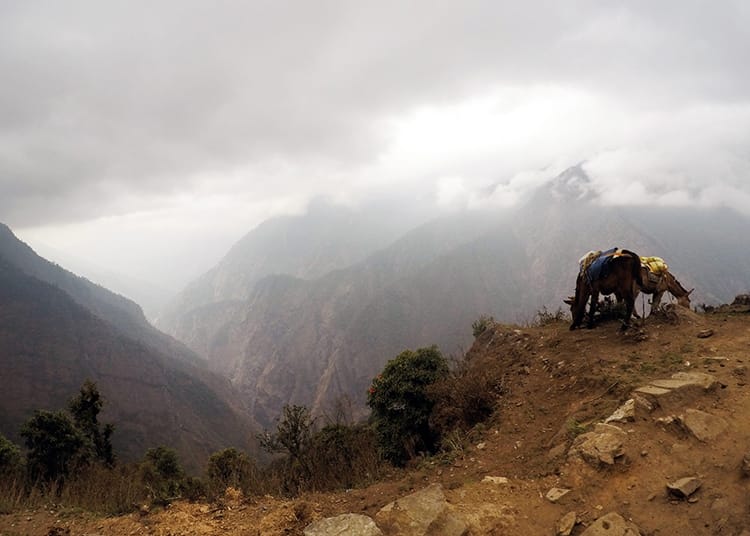
Day 2 – Paiya to Panggom
It turns out that yesterday’s insecurities and nausea were brought to you by my period, which thought it would arrive 10 days early. Warning: gentlemen who feel uncomfortable talking about “girly issues,” you can scroll down to day three. I had scheduled this trek around my period, but due to flight delays, I likely would have gotten a lovely surprise on summit day. Meaning, this early arrival is actually a good thing. Imagine with me, climbing a mountain while being overly sensitive, having cramps, and battling mood swings. Add in having to find a place to change a pad or tampon when the only things around you are cliffs covered in snow. Not even a tree to take cover behind. Oh yeah, and it’s -25 degrees Celsius (-13F) and frost bite is a thing.
All of that equals one giant pain in the ass that men don’t ever have to deal with. Which means my guide wouldn’t be very empathetic. In conclusion, girls who climb mountains are badass. But overall, this stroke of luck means I can deal with my “girly issues” way before hitting the barren snow filled summit.
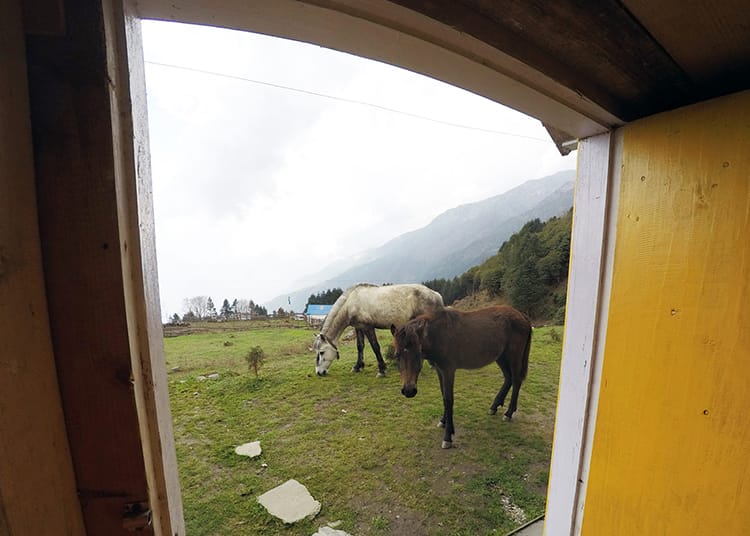
Day 3 – Panggom to Ramailo Dando
My guide makes the decision for us to walk two hours longer than the itinerary says. Yesterday was twice as long as it was supposed to be, and today we add two hours. I’m furious and exhausted and want to cry. Why do we have to go further than my little printed itinerary says? I feel like a child about to have a tantrum.
As we walk, I kill time by making lists in my head. Body parts that don’t hurt takes some effort. Ears. Pinky toes. Left arm. Foods I’d like to eat is easier. Eggplant parmesan. Lobster. Steak. Fried chicken. Instead I’ll have dal baht (rice and lentil soup) … again. Although delicious, it’s a bit uninspiring once you’ve had it for lunch and dinner several days in a row.
I’ve finally met another trekker, Asar, from Jordan. As we sit in the teahouse, I try to stretch and reach for my toes with no success. We burst out laughing as I tell him that I actually do yoga. We look rather pathetic as we stare at items across the room and refuse to make a move to get them. The accommodations have been super basic thus far, so Asar asks his guide if there is WiFi at Ramailo Dando.
“Not today, not tomorrow, maybe next day,” his Sherpa replies.
“Is there electricity to charge things?”
“Not today, not tomorrow, maybe next day.”
“Is there running water?”
“Not today, not tomorrow, maybe next day,”
“God, the next two days’ sound rough,” he says in his gruff voice with a laugh.
“There’s only a bed and a toilet,” I chime in.
“Bed yes. Toilet might be a bush,” says the guide laughing, but I’m pretty sure he’s not joking.
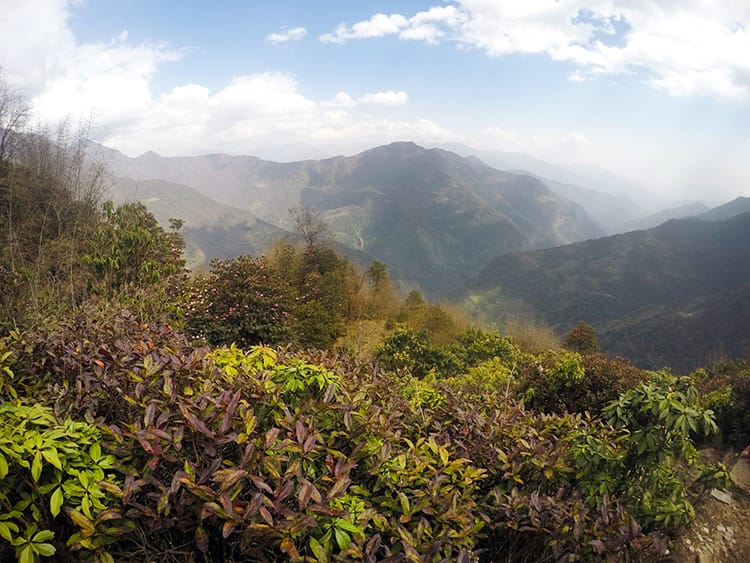
Day 4 – Ramailo Dando to Taktho
After walking through beautiful rhododendron forests that look straight out of a fairy tale, the trail gets steeper and the heat radiating off the sun becomes draining. I swear I’ve drank a liter and a half of water and haven’t peed all morning. I roll up to lunch and plop down next to Asar. “You don’t even have to say hi,” he says as I try to wave my hand in greeting, but it looks more like a spasm. According to his GPS watch, we’ve already walked uphill 1,300m (4,265 feet) and 14km (8.6 miles) in distance. Truth is, we probably aren’t even halfway to our destination.
“I think my toenails are going to fall off,” I say looking at my feet.
“Ah yes, trekkers feet. No sandals for you missy,” says Asar.
“Yup, they’re pretty gnarly looking,” I agree.
“Trekkers feet, but also a trekkers ass. Just tell the boys not to look too far down.” My only motivation for continuing.
Asar moves on while I wait for my lunch. Inside the lodge, Nepali music is playing, but somehow EDM has become popular among people in the Himalaya. I’ve grown used to hearing dub step between traditional songs, but suddenly Young, Wild & Free by Snoop Dogg comes on, and everyone stops to look in my direction as the lyrics, “So what we get drunk. So what we smoke weed,” begins to play loudly. I start to smile and the whole room erupts in laughter.
The fun doesn’t last long though. We begin to hike again, and I’m literally dragging my body uphill. A fog wraps around us, and I can’t see more than 30 feet in any direction. The beautiful views are gone, and suddenly, it’s freezing cold and damp. As we approach an old landslide, my legs are shaky with fatigue. I very carefully plant each foot on the narrow pathway trying not to look down to my right at what awaits me if I slip. I feel unsteady, my balance off, and my mind amiss. As I struggle, I see my guide trotting ahead at a brisk pace. When he turns back, I realize that he’s watching YouTube videos on his phone as he walks.
“Here, I’ll take your bag,” he insists after he notices I’m struggling.
“No,” I say defiantly. “I’ve got this. I feel great.” My exhaustion and hunger along with my period have made me extra grouchy, and I refuse to accept help from someone who thought I couldn’t handle the original itinerary. I don’t need a man. I can do anything he can. I’m a motherf***ing feminist. I can do this. I can do this. I can do this. I repeat it over and over in my head.
It’s freezing. I’m shivering in the mist coming off the clouds, and the tea house is still an hour away. I want to give up, but there is nowhere for me to go. I start to slip with every other step as the rocks become damp. After an excruciatingly long time, we make it to the teahouse. I walk straight to my room, lock the door, curl up in a ball and cry. Tears stream down my face. I’m exhausted and starving. My body is still shaking from the cold. Today is the day that broke me. I can’t do this.
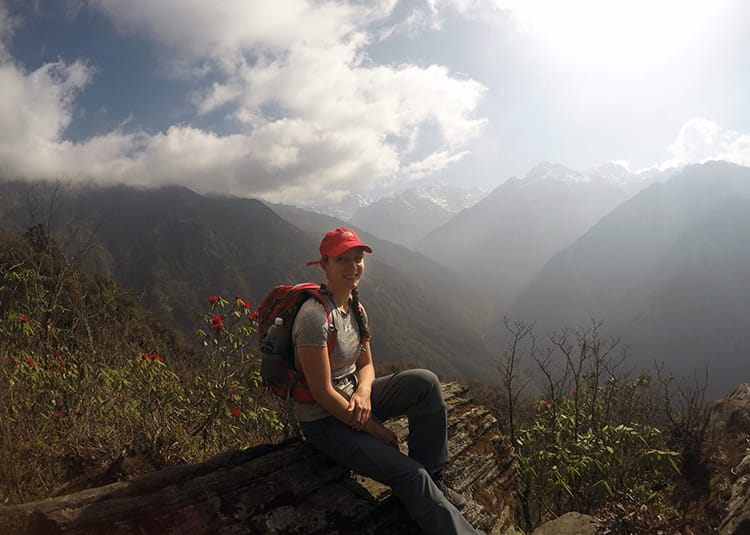
Day 5 – Taktho to Kothe
When I told people I was going to do the Mera Peak Trek, they had two reactions. Those who knew nothing about the mountains reacted with enthusiasm, telling me that of course I’d make it. I know that even if I try my best, summiting isn’t entirely in my control. There are other factors to worry about like weather, altitude, etc.
Then there was a second kind of reaction, mostly from men, mountain climbers, etc. They’d look me up and down and respond with things like, “You know that’s not an easy peak right?” or “Not everyone makes it.” As if they were helping me to accept my faith. I never thought the trek would be easy, and I honestly don’t know if I’ll make it, but most of trekking is mental, and that’s a strength you can’t see from looking someone up and down.
Today is an easy short walk compared to the past days. It’s exactly what I need. We make it to the next hotel early enough for me to take a hot shower. Its half a bucket of boiling water mixed with half a bucket of cold water and a spout on the bottom in lieu of a shower head. It’s easily one of the best showers I’ve ever taken. As if I’m washing yesterday’s negativity off me.
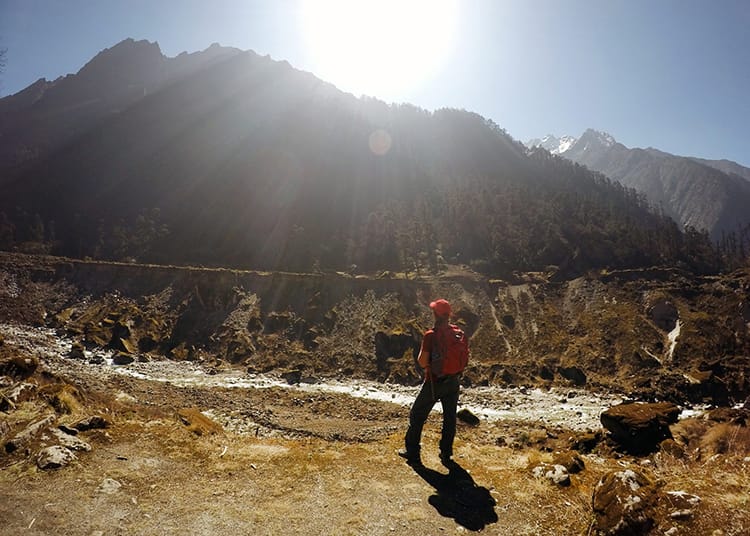
Day 6 – Kothe to Thangnak
I’m eating breakfast and staring at a poster on the wall of a random white baby in a diaper with clipart flowers photoshopped around it. It says, “Good Morning” in a large bold font. Whose baby is this? And how did it end up in a tea house in the Himalaya? My guide walks by, so I point and ask, “What’s with the baby?” He shrugs and laughs, not offering an explanation. I guess some things aren’t meant to be explained.
As I walk my mind jumps from thought to thought. Last time I was in Nepal; I fell madly in love with this country. I can’t really explain it, but I couldn’t wait to come back. I was so worried that I’d get here and it wouldn’t live up to my expectations. Maybe I romanticized it for myself, but I’ve been here a month, and I love it even more. Here’s the thing, I wasn’t really sure where else I wanted to go after Nepal, and I think the truth is that I couldn’t pick another place because I’ve always wanted to stay here longer. I’m going to extend my visa for two more months. Somehow, Nepal feels like my second home, and this revelation makes me smile.
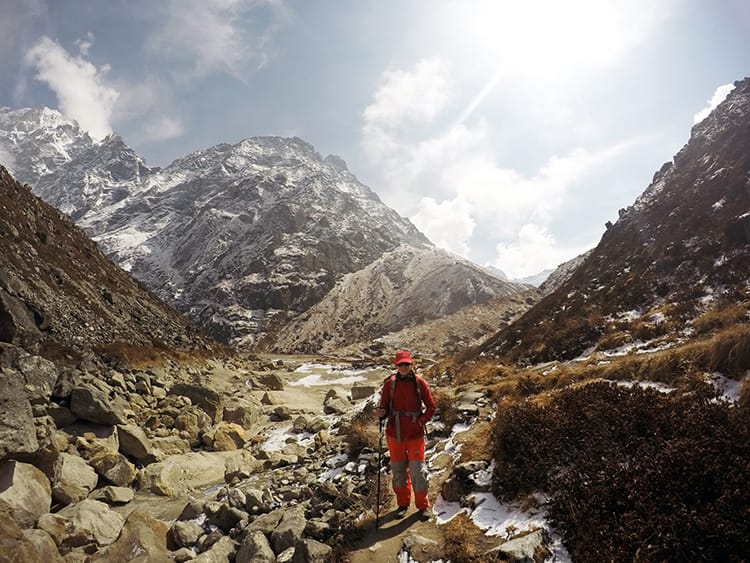
Day 7 – Thangnak to Khare
My guide appears to have a stash of speed which he has been hiding from me. He runs up hills and waits at the top as I stare down at the ground moving slower than a turtle going in reverse. He has techno music pumping through his portable speaker and as far as I can tell, his veins.
A few days ago, I met two Dutch people who are here to track glacier melt. While one would think that we discussed important things like climate change, we took to more imperative topics. For instance, the worst ways to be helicopter evacuated. The worst, we all agreed was getting frost bite on your ass while going to the bathroom at High Camp. The second favorite, was slipping on a frozen squat toilet and breaking an ankle. My nightmare seems to be coming true as we arrive in Khare and the toilet floor is frozen in a sheet of ice, making balancing and not peeing on oneself an interesting game.
I’ve been trying to eat less meat for a while now and have deemed myself a flexible vegetarian or a “flexi-tarian.” Trekking appears to be my downfall. I’m ashamed to admit that I brought a bag of beef jerky into a Hindu country where cows are considered gods. Now, I sit in my room and hold the meaty treat in front of me like Gollum in Lord of the Rings. Hunched over and ashamed, I devour and relish every bite. At this point, it’s possible I’m losing my mind.
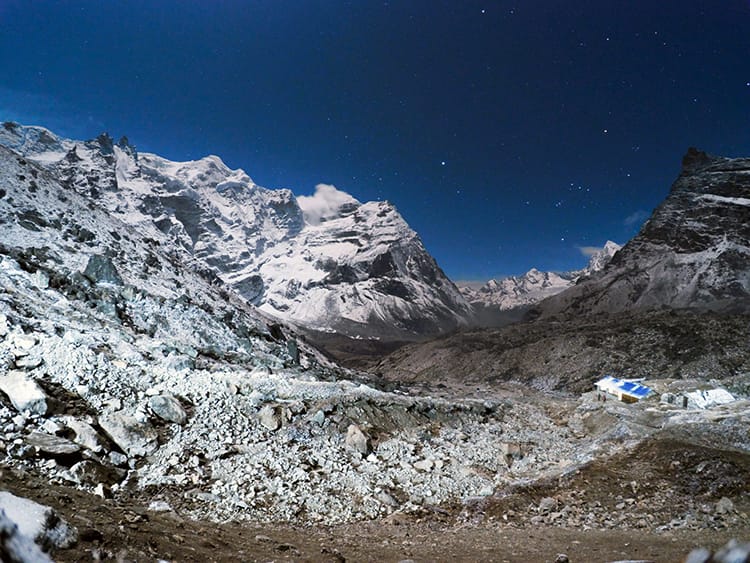
Day 8 – Khare Acclimation Day
Today is a rest day so we stay put in Khare and do a quick one-hour acclimation hike. The views are amazing but at this altitude, walking pretty much consists of staring at one’s feet. Each step takes some effort and the ground is uneven and rocky. It’s odd how much of trekking is really just starring down. A Nepali women told me she tried trekking once and all she saw was her feet. Now I realize, she’s kind of right. I could probably describe the change in rocks depending on the altitude here in great detail, but don’t worry, I won’t bore you with that.

Day 9 – Khare to High Camp
My rental boots are chunky and heavy. Every time I lift my foot, I feel as though someone has attached a weight to it. I move up the uneven rocks, slipping and sliding like a clumsy child learning to walk. A clumsy child learning to walk on slippery rocks with a cliff on one side. It’s a bit unsettling.
Base Camp appears in the distance and half the people on route to Mera Peak stop for the night. I’m jealous. We’ll continue on, and just past the camp we stop to attach our crampons. As the device, which looks like it’s made for torture, is attached to my foot, I hear a familiar shout in the background. “Michelle!” It’s my two favorite Aussi’s, Andrew and Jeff, who I ran into in Thangnak. We all suit up together, but they’ll go to a second Base Camp, and I’ll go to High Camp. I’m jealous of them too.
Once they set off, a thick cloud rolls in and envelops them. They disappear into the mist as if they were never there. The sky blends in with the snow, and I can’t see more than ten feet in front of me. It’s like walking into a white wall. I grab onto the fixed ropes and ascend the uphill treadmill to nowhere. I have no sense of how far I’ve come or how far I have yet to go. It’s purgatory.
Suddenly, a beast of a creature comes bounding down the mountain towards me. Do they have bears up here? Maybe it’s a yak, although I haven’t seen any on this trek. Perhaps, a yeti? Behind it, two men appear giving it scale, and I realize it’s closer than I thought. It’s not a beast at all. It’s the mountain dog that’s been following us over the last few days. I named her Kali after a fierce Hindu goddess. She leaps up to me, clearly remembering the rub down I gave her in Khare and Kothe. I ask if she summited, and she hands me her paw. I take that as a yes. The man who appears behind her starts to come into view. It’s Dian, the Chinese-American dentist I met earlier in the trek. He’s summited despite the bad weather and is heading back in record time.
As we get higher, less and less people appear. I hear voices that sound like they’re right next to me, but when I look, no one is there. Like ghosts in the wind. Each step takes focus. My stomach feels tight, and I throw up a little in my mouth. Quickly, I bend over to let it out, but as I kneel in the snow coughing, nothing comes up. Vomiting is a sign of altitude sickness, but I don’t have a headache yet which is good. My guide hovers over me, waiting for me to pull myself together. He looks at his watch, and I know it’s getting late. I’m moving too slow.
I stand up and stare at the ground. One single step is one step closer to camp. I lift my foot and put it down. You are strong. I take a breath and lift the right foot and place it in the snow. You’re not weak. Again, I move a foot forward with a deep breath. You are confident. Another. You are peaceful. At this slow pace I can keep ascending without stopping. I stare at my mountain boots and force each foot to move. My stomach tightens again, but I don’t stop.
Another person comes into view, they’re descending. A quick “Namaste” and they disappear into the abyss. I feel like we are all wanderers lost in another world. Stuck here, going different directions. Where are we going, and the question I keep asking myself, why? Suddenly, the sky clears and Tibetan prayer flags materialize up a steep hill. High Camp is in the distance. After a tough final push, I make it to our tent. As soon as I sit down, I feel it. The headache.

Day 10 – High Camp to Summit to Khare
I’m up all night, unable to sleep because of the shooting pain surrounding my right eye. It’s 2:00am and time to get up to summit. I debate in my head whether or not to try. This is the first sign of altitude sickness, and the rule is not to go up in elevation. I swallow some altitude medicine, and we wait an hour to see if it goes away. There’s no change, so we push back another hour and then another. The sun has risen and my headache only seems to be getting worse.
“We can stay another night. Maybe your headache go away.”
As soon as I step outside into the glaring sunlight, the headache hits full force. Like being slammed in the back of the head with a baseball bat. My brain feels fried, and I can’t focus. It’s debilitating. I walk down some rocks away from camp to go to the bathroom, and my body feels clumsy. Like I’ve been drinking all night. I stumble down the rocks and have to sit and shimmy down parts to avoid tripping.
When I make it back inside the tent, I try to lay down but I’m breathing too hard. I have to sit up to catch my breath. I rest my head on my knees and try to calm my mind. The pain isn’t that bad. You’re ok. Just breath. I try to convince myself it’s impermanent, but the pounding doesn’t stop. The ache is coming from every side and every angle. My entire brain feels like it’s been scrambled and someone’s slowly churning it inside my skull. I can’t stay here another night. I don’t think I can stay another minute. I have to descend.
After popping a pain killer, I lace up my boots, and start to walk down the mountain. A blizzard hit us last night, making today a difficult day to summit, but a great day to go downhill. My boots slide through the fresh snow as if I’m skiing. We start moving fast and my headache starts to disippate. I’m on a bit of an oxygen high when suddenly I’m up to my waist in snow. I look around and laugh, realizing I’ve fallen into a small crevice that was covered up during the storm. Luckily, my giant size 9 boots got caught on a ledge.
On the way down, all the groups I’ve met over the last few days are headed up. They ask if I’ve summited, and I blaze down the mountain yelling gleefully back at them “No, altitude sickness!” Summiting was the goal, but it was never about the summit for me. 5,800 meters (19,028 feet)is higher than I’ve ever been, and getting to High Camp showed me how much I could accomplish. It’s the hardest thing I’ve done up until this point, and having the maturity to know when to turn around shows me how much I’ve grown this last year. I’ve never felt prouder of what most people would see as a failure.
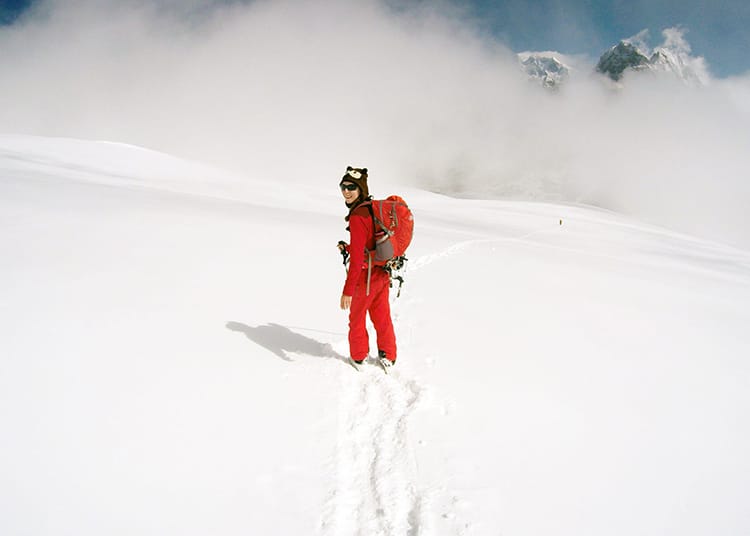
Day 11 – Khare to Kothe
The weather in May is usually beautiful, but this year, it’s decided to turn to monsoon season early. What should be a nice easy walk ends up being a walk through snow, hail and rain. A man is passing me on the trail when I realize we’ve been playing leap frog all morning. I decide to speak to him in Nepali for practice and to kill some time.
“Hello. How are you?”
“You speak Nepali!”
“A little. I am learning.”
“Very good. I’m good and you?”
“I’m okay.”
“My name is Nima, and yours?”
“My name is Michelle.”
“What country are you from.”
“I’m from America.”
“Do you like Nepal?”
“I like your country a lot.”
Then he says something I can’t understand. I look at him puzzled and ask him to repeat it slowly. In English he says, “It means… Your Nepali is very good. I’m proud of you.”
These simple words make my heart smile. This journey has never been about standing on top of a mountain. I think if you walk for 16 days and only feel that 5 minutes of it is important, then you’ll be let down no matter what. For me, the little moments mean the most to me. Even if my language skills were equivalent to a three-year-old, being able to communicate in another language with a stranger was special to me. The fact that he was proud almost made me cry.
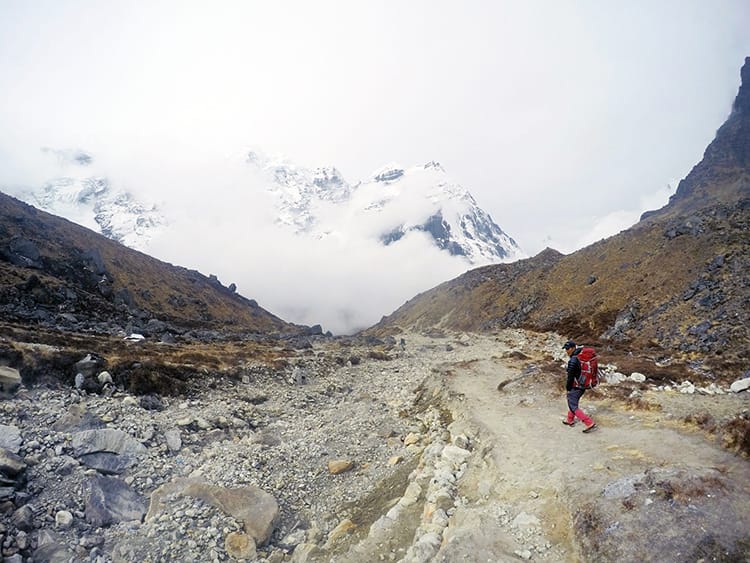
Day 12 – Kothe to Thuli Kharka
My guide has the flu, so I move forward without him. From now on the porter, Pisang, will act as my guide. He’s sixteen and starts school again in a few days. As we get going, I realize we are actually in front of all the other groups. It’s the first time that’s happened in 12 days. I’m walking past a tea house when I look to my right and see my favorite mountain dog, Kali, snuggled up between some backpacks. I make a “tsssk” sound and she lifts he head, groggy with sleep. As soon as she sees it’s me, she leaps up and snuggles in my arms.
Kali must realize that I’m sans guide, and decides to take over the roll. She walks ahead, but never more than 100 feet, constantly looking back and waiting for Pisang and I to catch up. As we gain altitude, it begins to hail. The little white pellets bounce off the ground like popcorn and hit my skin as hard as miniature bullets. Kali circles back and begins to whine. Within seconds thunder booms in the distance. We’re standing in the open and are completely exposed. I hope Pisang will know what to do if the storm gets worse.
The thunder grows further away and the hail turns to a soft wet snow. Kali waits ahead while Pisang is navigating a rough patch behind me. I stand there alone as the snow begins to fall in slow motion. I can see every individual snowflake falling in the distance. As if someone has hit pause on the world. It’s perfect.
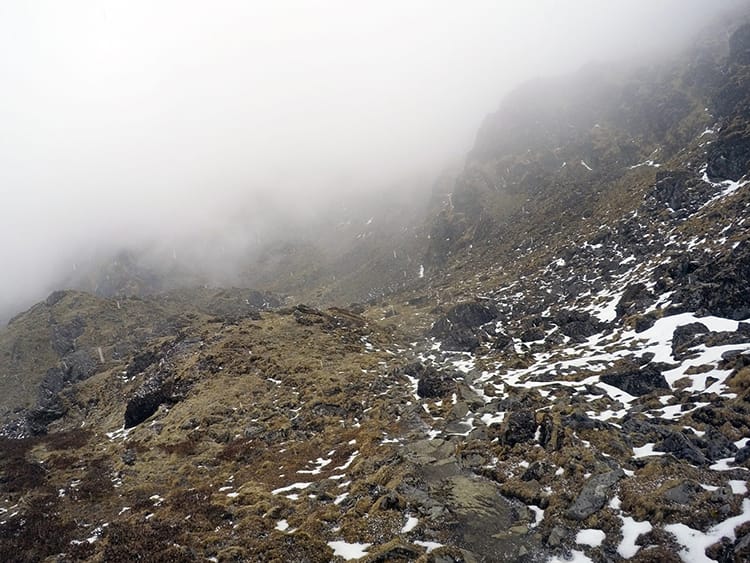
Day 13 – Thuli Kharka to Lukla
As I eat breakfast, I hear all the other groups getting instructions for the day. Mountain climbing boots and crampons will be necessary because of yesterday’s snow storm. Everyone should be prepared for slippery conditions. I look around as the 20 trekkers in my tea house get themselves ready, and then I look at my feet. I have hiking sneakers. Not even hiking boots. I look back up at all the others attaching bits and pieces to their shoes and asking their guides questions. Not only do I have the wrong shoes, I don’t even have a guide. Maybe it won’t be so bad. Sometimes the western guides over exaggerate.
Starting out, we head up a steep incline which is exhausting, but really not that slippery. I’ve totally got this. No big deal. I’ll just be super careful of where I step. Reaching the top brings on some amazing views, but then I see why all the other guides were so adamant about their trekkers footwear. Ahead of me, there’s a thin path in the snow wide enough for one foot. The angle of the mountain is about 45 degrees, and the teeny tiny path just teeters in the middle with no support below it. If you slip, you’ll slide down at least a 1,000m (3,280 ft) drop with nothing to grab onto.
Behind me, a girl is roped to her guide. Ahead, the trekkers wear full mountaineering gear. Two other unprepared trekkers have their guide forming a staircase for them with an ice axe. I just have Pisang, who although amazing, is trying not to fall while balancing my giant bag on his head. At the difficult parts, he stops to hold my hand or tries to make little foot holes with his feet. I could hug him for trying so hard.
We arrive at a point where the path goes straight down for about 10 feet. It doesn’t sound like much, but it’s solid ice with nothing to grab onto, and if you get too much momentum you might not stop. It’s the kind of place where if you fall, you won’t survive. My hands are sweating and my emotions are a wreck. I’m on the verge of tears. I just want to be done. I‘m so tired of the snow. I’m tired of the cold. I’m tired of this trek. I want to go home. I take a step and my left foot begins to slid down the mountain and tears start to stream down my face. My trekking pole catches me, and I’m able to get my footing.
Once my porter sees that I’m about to break down in tears, he takes one of his crampons off and hands it to me with a smile. We’ll each use one. He walks ahead of me, and I pray to every god that he doesn’t slip because I’m using his only form of safety. My bag weighs at least 16kg (35 lbs). I can’t even imagine trying to walk this with extra weight on my back. When we finally get over the pass, I realize my entire body is shaking. I can’t tell if it’s adrenaline, fatigue or pure fear and relief all mixed into one.

The Mera Peak Trek in Retrospect
It seems like there are so many times in life when we set arbitrary goals. Summiting 6,500m means I’m good enough. If I can make it there, I’m better than those who couldn’t. If I can summit, I’m worthy. We place these ideas in our heads like little seeds. As time goes on, we water them and watch them grow. We tell ourselves that not making it to the top is a failure. We compare ourselves to others. We put ourselves down. We take things that are meant to be beautiful and warp them into an ego boost. We let our success and failure define us.
Somewhere along the way, I’ve learned not to compare myself to others accomplishments. I’ve learned not to compete with someone else’s success. I’ve learned that the destination is not the most important part of the journey. At some point, I stopped telling myself that I needed to accomplish something to measure up. To be worthy. If there’s one thing I’ve learned on this trek, it’s this: I am enough.
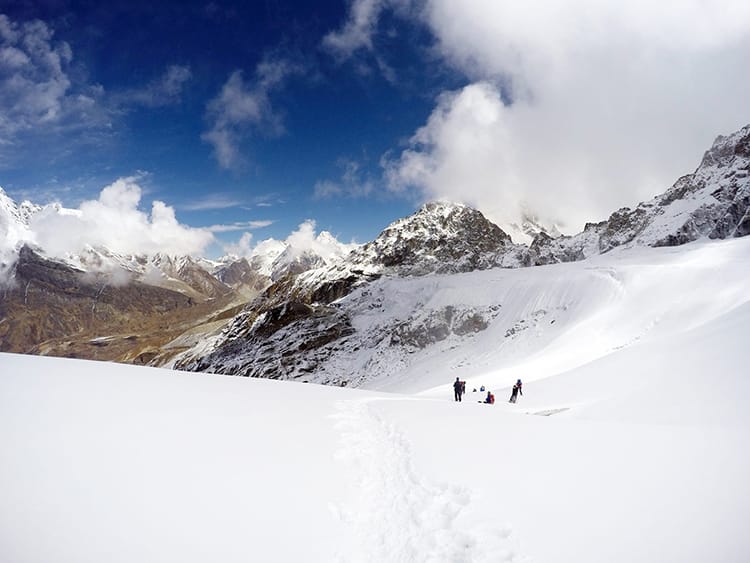
Special thanks to Swotah Travel & Adventure for arranging my trek.
Like this post? Pin it for later…
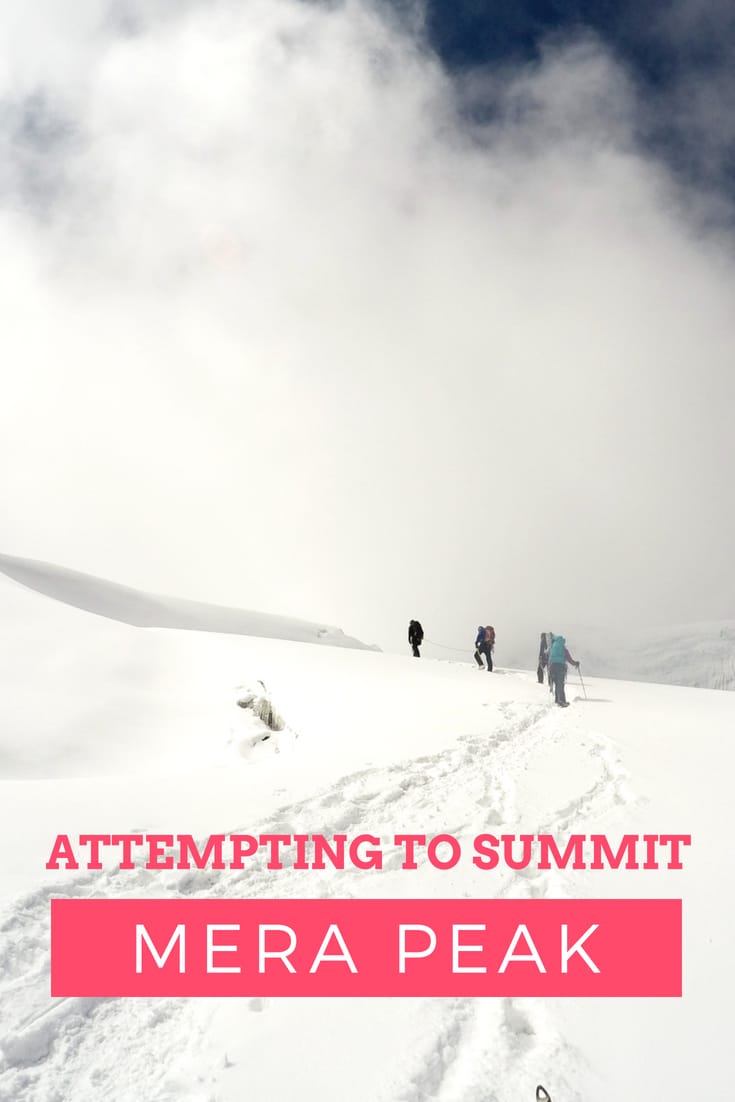
You might also like…

Michelle Della Giovanna
Writer at Full Time Explorer
I’m just your average New Yorker who quit her job in the fashion industry to explore the world. Come find out what it’s like to trade in five-inch heels for squat toilets.
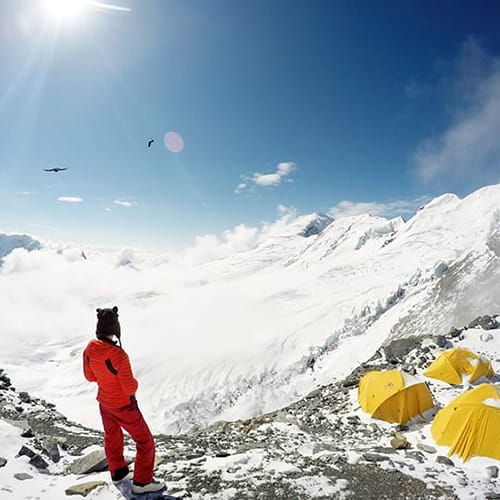
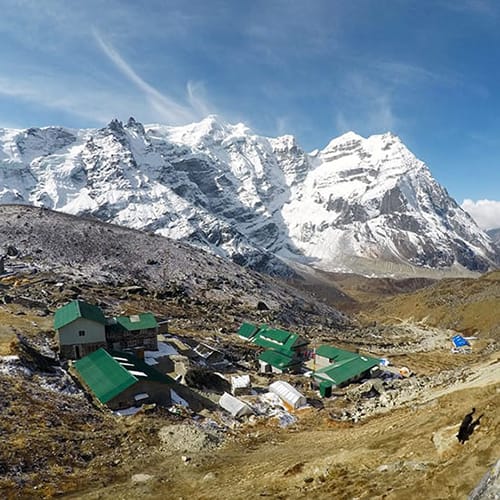
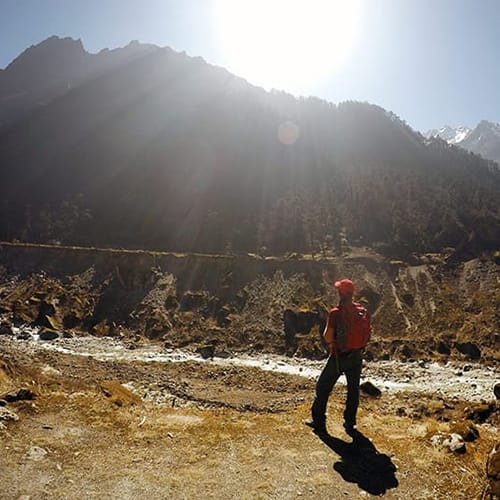
You’ve got my respect. What you did is amazing and you should be proud of it. I really enjoyed reading your blog. I’m planning to do this trek next month.
You have a very wonderful blog, keep it up 🙂
Thank you so much! That means a lot. Have an amazing time on the trek and let me know if you have any questions about it. It’s such an incredible experience
You said With no experience, You attempted the Mera Peak Trek in the Everest Region I want to know about your preparation while planning for the Himalayas? You must be new to climbing but experienced trekker mera peak is in my wishlist but while browsing the web I figured it does require some sort of skills while scaling up plus high altitude experience is a must right? can you suggest some tips or preparation for this peak?
Hey! No I didn’t have any climbing experience. Many people learn climbing technique on this peak. I did have trekking experience. It’s not a must but it’s definitely helpful and being in good shape is necessary.
Thank you for your words here, appreciated it. You push your limits and scaled Mera how cool is that so inspiring for me.
Thank you!
Thanks so much for posting your experience. I’ll be heading up to mera peak trek in 3 weeks and I’m so nervous! But I’m with you on this, my goal is also high camp and anything higher would be icing on the cake. You’re story is so damn inspiring! Love it!
Awe thank you so much! You’re going to be amazing! Enjoy every minute (even the tough ones haha) 😉
So happy to have come across your blog. I just finished Manaslu trek and had similar altitude sickness (we also had to flee a landslide and my ankle twisted). Your wisdom in the end of your adventure resonates. Your speaking native language is a sign of utmost respect, also going beyond your comfort zone that everyone can see. good wishes and wonderful travels!
Thank you so much Scott for your kind words! It sounds like you had a crazy adventure as well. I’m looking forward to doing manaslu this year ☺️
This trip’s precise itinerary, backstory, and history are utterly captivating and realistic. Looking forward to more of these blogs in the future, buddy!
thank you for the informative post, will love to comeback for more.
Thank you!
Thanks for sharing this article with us.
Thank you for sharing informative blog.
The information is very useful as well as helpful for trekkers who want to do Peak climbing in Nepal. Thank you for the info!!
Wow you had really nice adventure trip and thanks for wonderful writing.
thank you!
Incredibly inspiring write-up! Climbing Mera Peak sounds like an unforgettable adventure. Thanks for sharing your experience and tips, very motivating!